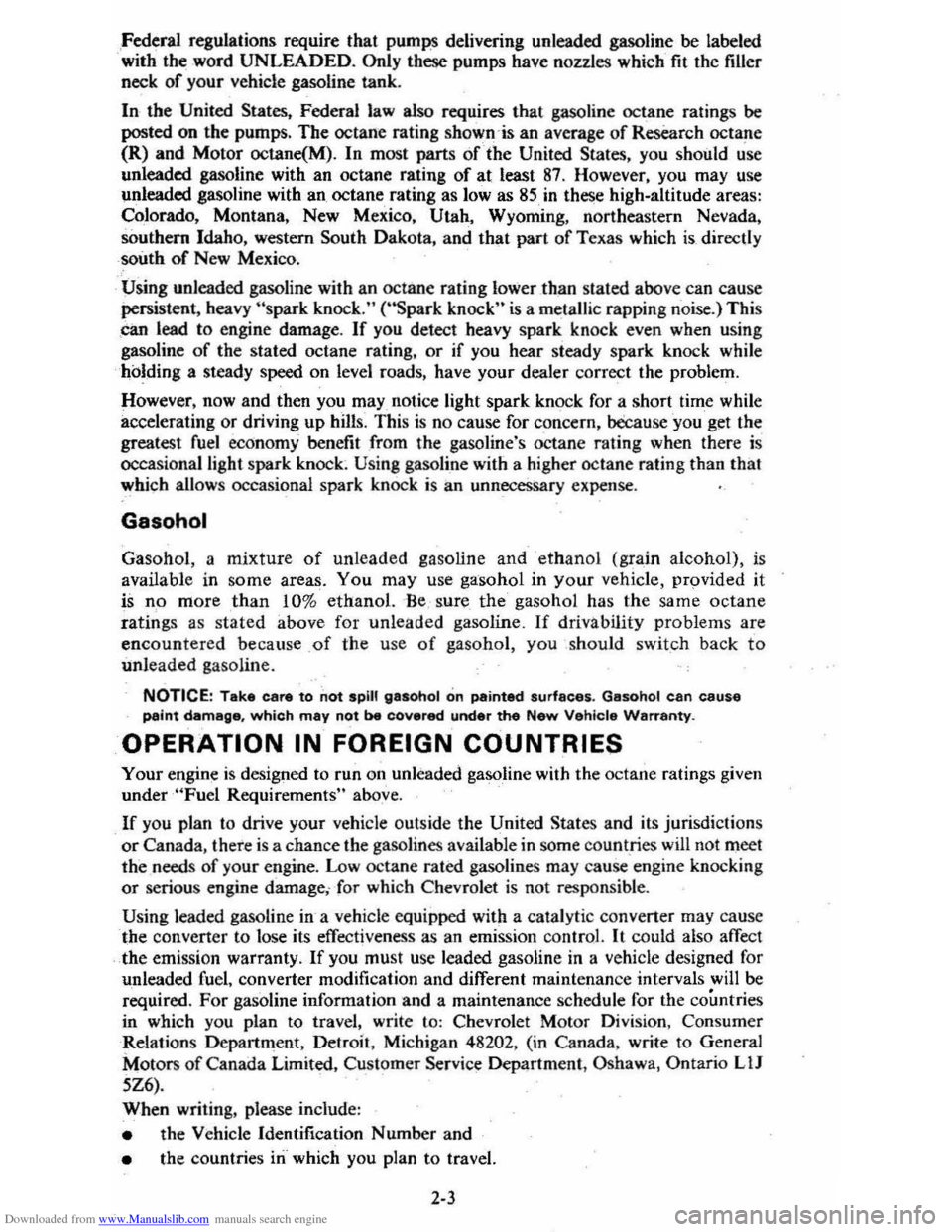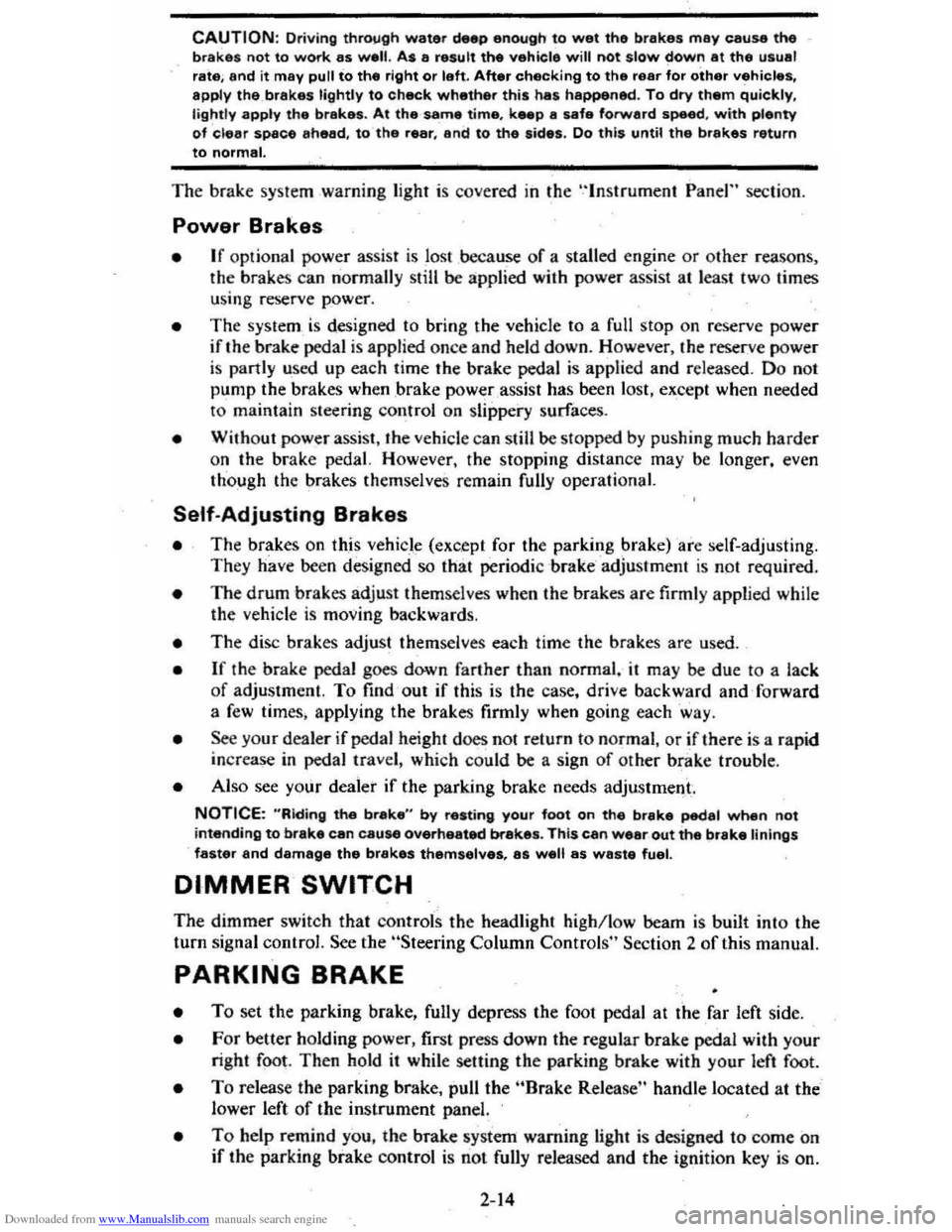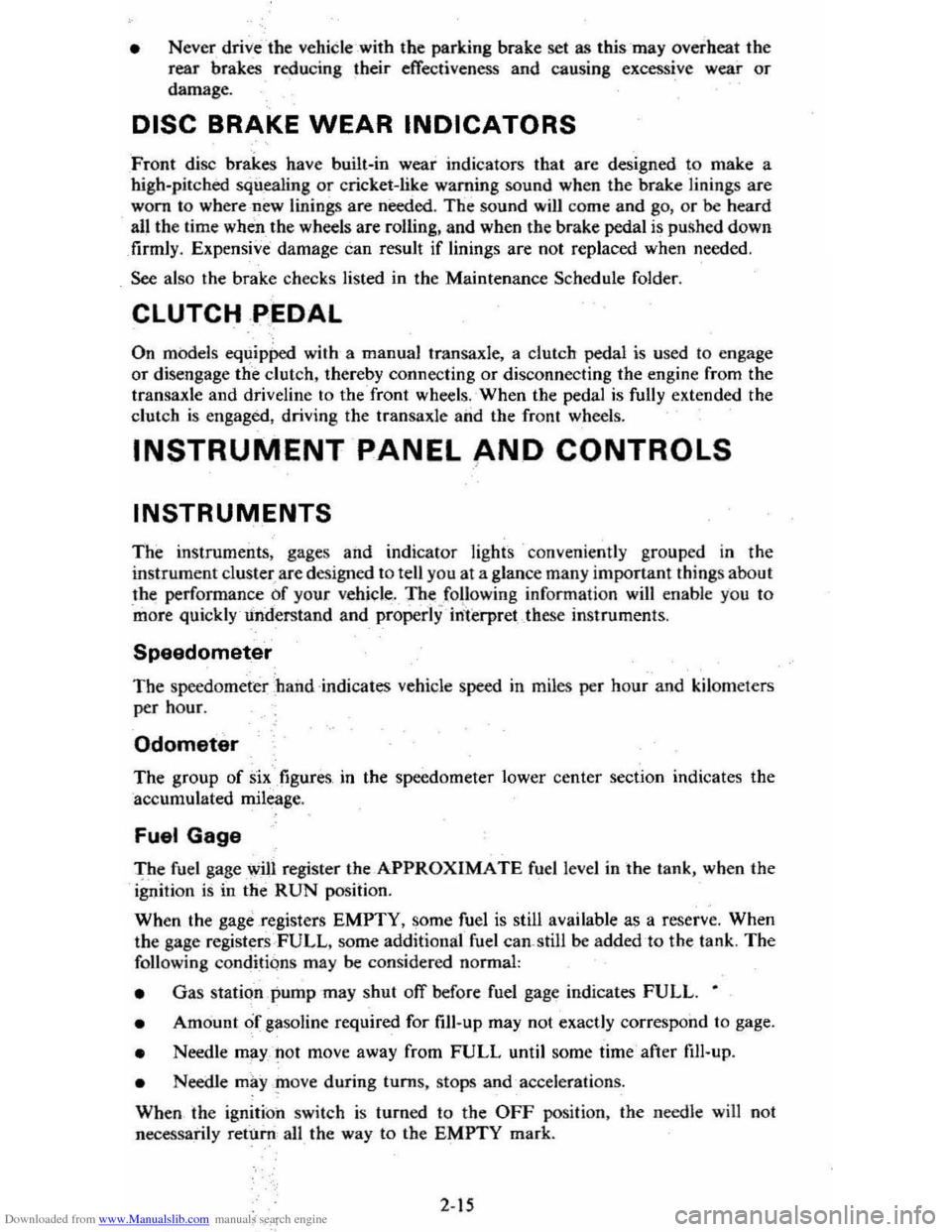1980 CHEVROLET CITATION fuel pump
[x] Cancel search: fuel pumpPage 20 of 95

Downloaded from www.Manualslib.com manuals search engine Federa1 regulations require that pumps delivering unleaded gasoline be labeled
with the word UNLEADED. Only these pumps have nozzles which fit the filler
neck of your vehicle gasoline tank.
In -the United
States, Federal law also requires that gasoline octane ratings be
posted on the pumps. The octane rating shown -is an average of Research octa!1e (R) and Motor octane(M). In most parts of the United States, you should use
unleaded gasoline with an octane rating
of at least 87. However, you may use
unleaded gaSOline with an octane rating as low as 85 in thes:e high-altitude areas:
Colorado , Montana, New Mexico, Utah. Wyoming. northeastern Nevada.
southern Idaho, western South Dakota, and that part
of Texas which is directly south of New Mexico.
Using unleaded gasoline with an octane rating
lower _than staled above can cause persistent , heavy "spark knock." (''Spark knock" is a metallic rapping noise.) This
can lead to engine damage. If you detect heavy spark knock even when using
gasoline of the stated octane rating, or if you hear steady spark knock while
holding a steady speed on level roads, have your dealer correct the problem.
However. now and then you may
notice light spark knock for a short time while
accelerating or driving up hills. This is no cause for concern, because you get the
greatest
fuel economy benefit from the gasoline's octane rating when there is occasional light spark knock~ Using gasoline with a higher octane rating than that
which allows occasional spark knock is an unneceSsary expense.
Gasohol
Gasohol , a mixture of unlead ed gasoline and ethanol (grain alcohol), is
available in some areas. You may use gasohol in your vehicle, provided it
is
no more than 10% ethanol. 'Be: sure the gasohol has the same octane
ratings as stated above for unleaded gasoline. If drivability problems are
encountered because _of the use of gasohol, you should switch back to
unleaded gas oline.
NOTICE: Take care to not spill gasohol on painted surfaces. Gasohol can cause paint damage, which may not be covered under the New Vehicle Warranty.
OPERATION IN FOREIGN COUNTRIES
Your engin~ is designed to run on unleaded gasoline with the octane ratings given
under '''Fuel Requirements" above .
If you plan to drive your vehicle outside the United States and its jurisdictions
or Canada, there is a chance the gasolines available in some count,ries will not meet the needs of your engine. Low octane rated gasolines may cause engine knocking
or serious engine damage,: for which Chevrolet is not respon sible .
Using leaded gasoline
in-a vehicle equipped with a catalytic converter may cause
the converter to lose its effectiveness as an emission control.
It could also affect
the emission warranty.
If you must use leaded gasoline in a vehicle designed for
unleaded fuel, converter modification and different maintenance intervals will be
required.
For gasoline information and a maintenance schedule for the countries
in which you plan to travel, write to: Chevrolet Motor Division, Consumer
Relations Department, Detroit, Michigan 48202, (in Canada , write to General
Motors of Canada Limited. Customer Service Department , Oshawa, Ontario LlJ
5Z6).
When writing, please include :
• the Vehicle Identification Number and
• the countries in which you plan to travel.
2-3
Page 31 of 95

Downloaded from www.Manualslib.com manuals search engine CAUTION: Driving thr~gh water deep enough to wet the brakes may cause the brakes not to work as well. As 8 result the vehicle will not slow down at the usual
rate ; and it may pull to the right or left. After checking to the rear for other vehicle., apply the brakes lightly to check whether this has happened. To dry them quickly, lightly apply the brakes. At the-same time, k .. p a safe forward speed, with plenty of clear space ahead, to the rear, and to the side •. 00 this until the brakes return to normal.
The brake system warning light is covered in the "Instrument Panel" section.
Power Brakes
• If optional power assis t is lost because of a stalled engine or other reasons .
the brakes can normally still be applied with power assist at leas t two times
u sing reserv e power.
• Th e system is designed to bring the vehicle to a full stop on reserve power if the brake pedal is applied once and held down . However . the reserve power
is partly used up each time the brake pedal is applied and rele ased. Do not
pump the brakes when ,brake power assist has been lost, except when needed
to maintain steering control on slippery surfaces.
• Without power assist, the vehicle can still be stopped by pushing much harder
o n the brake pedal. However, the stopping distance may be longer. even
though the brakes themselves remain fully operational.
Self-Adjusting Brakes
• The brakes on this vehicle (exc,ept for the parking brake) are self-adjusting.
They have been design ed so
that periodic brake adjustment is not required.
• The drum brakes adjust themselves when the brakes are firml y applied while
the vehicle is moving backwards.
• The disc brakes adjust themselve s each time the brakes are used.
• If the brak e pedal goes down farther than nonnal. it may be due to a lack
of adjustment. To find out if this is the case, drive backward and forward
a few times , applying the brakes firmly when going each way.
• See yo ur dealer if pedal height does not return to normal, or if there is a rapid
increase in pedal travel, which could be a sign of other brake trouble .
• Also see your dealer if the parking brake needs adjustment' .
NOTICE: "Riding the brake" by resting your foot on the brake pedal when not intending to brake can cause overheated brakes. This can waar out the brake linings faster and damage the brakas thamselvas, 85 well 8S waste fuel.
DIMMER SWITCH
The dimmer switch that controls the headlight high/lo w beam is built into the
turn signal control. See the "Steering Column Controls" Section 2 of this manual.
PARKING BRAKE
• To set the parking brake, fully depress the foot pedal at the far left side.
• For better holding power, first press down the regular brake pedal with your
right foot. Then hold it while setting the parking brake with your lefl foo[.
•
To release the parking brake, pull the "Brake Release" handle located at the
lower left of the instrument panel.
• To help remind you. the brake system warning light is designed to come on if the parking brake control is not fully released and the ignition key is on.
2-14
Page 32 of 95

Downloaded from www.Manualslib.com manuals search engine • Never drive-the vehicle _with the parking brake set as this -may overheat the
reaf brakes reducing their effectiveness and causing excessive wear or damage,
DISC BRAKE WEAR INDICATORS
Front disc brakes have built-in wear indicators that are designed to make a
high-pitched
squealing or cricket-like warning sound when the brake linings are
worn 10 where -new linings are needed. The sound will come and go, or be heard
all the time
when the wheels are rolling, and when the brake pedal is pu~hed down
firmly . Expensive damage can result
if linings are not replaced when needed.
See also the brake checks listed in the Maintenance Schedule folder.
CLUTCH .PEDAL
On models equiPPed with a manual transaxle, a clutch pedal is used to engage
or disengage the clutch, thereby connecting
or disconnecting the engine from the
transaxle and drive1ine to the front wheels. -When the pedal is fully extended the
clutch
is engaged, driving the transaxle arid the front wheels.
INSTRUMENT PANEL P.ND CONTROLS
INSTRUMENTS
The instruments, gages and indicator lights conveniently grouped in the
instrument cluster are des igned to
tell you at a glance many important things about
_the perfonnance of your vehicle _, _ The following information will enable you to
more quickly -understand and properly it';:rerpretthese instruments.
Speedometer
The speedometer chand ·indicatt:5 vehicle speed in miles per hour and kilometers
per hour.
Odometer
The group of six figures . in the speedometer lower center section indicates the
accumulated mileage.
Fuel Gage
The fuel gagewiH register the_APPROXIMATE fuel level in the tank, when the
ignition
is in the RUN position.
When the gage registers
EMPTY, some fuel is still available as a reserve. When
the gage registers
FULL. some additional" fuel can"still be added to the tank. The
following conditiqns may be considered normal:
• Gas station _pump may shut off before fuel gage indicates FULL. •
•
Amount of gasoline required for fill-up may not exactly correspond to gage.
• Needle may not move away from FULL until some time after fill·up.
• Needle may !Dove during turns. stops and-accelerations.
When the ignition switch
is turned to the OFF position, the needle will not
necessarily
retiJrn · all the way to the EMPTY mark.
2-15